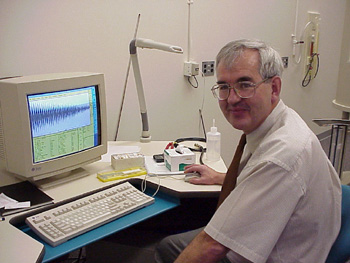
NMR spectroscopy is one of the most important and versatile techniques for
characterizing the structure and dynamics of molecules. Traditionally,
high-resolution NMR studies have been confined to isotropic liquid samples
because solids have a reputation of yielding broad featureless NMR spectra. Over
the past twenty years, several ingenious experimental techniques have been
devised to eliminate the line-width problem. There are many advantages of using
NMR to investigate solid materials and much of our research has involved
exploring applications of solid-state NMR. We have been particularly interested
in measuring the orientation dependence of the NMR chemical shifts, spin-spin
coupling constants and quadrupolar coupling constants using a variety of
techniques such as single-crystal NMR. In addition to experimentally measuring
these fundamental NMR parameters, their interpretation in terms of electronic
and molecular structure has been of considerable interest. Typically, our
experimental data are complemented by state-of-the-art ab-initio
molecular orbital calculations. The goal of this research is to obtain a better
understanding of magnetic shielding, spin-spin coupling and electric field
gradient tensors.
Other interests include applications of new multi-pulse NMR techniques, e.g.,
those designed to recouple both homonuclear and heteronuclear dipolar
interactions and techniques designed to obtain high-resolution NMR spectra of
half-integer quadrupolar nuclei such as the MQMAS experiment. We are also
actively involved is using the highest magnetic fields available for NMR studies
to investigate important quadrupolar nuclei with small magnetic moments (e.g.
25Mg, 35/37Cl, 53Cr, 91Zr,
95Mo). Although our studies have focused on traditional inorganic
systems, we tackle a wide range of diverse solid materials including
paramagnetic systems, surfaces and porous materials. Using spin-exchange optical
pumping techniques which utilize a 60 watt-diode laser system, 129Xe
nuclear spin population enhancements of approximately 104 are being
realized. This makes 129Xe NMR an ideal technique for investigating
the latter materials.
.jpg)
Phosphorus-31 NMR spectrum of a phosphole tetramer, obtained at an applied
magnetic field of 4.7 T with the sample spinning at the magic angle at a rage
of 2 kHz. The asterisk indicates the isotropic peak while the remaining peaks
are spinning sidebands
Selected Publications:
T. Ueda, T. Eguchi, N. Nakamura and R.E. Wasylishen, "High-Pressure
129Xe NMR Study of Xenon Confined in the Nanochannels of Solid
(±)-[Co(en)3]Cl3", J. Phys. Chem. B, 2003,
107, 180-185.
M.A.M. Forgeron, D.L. Bryce, R.E. Wasylishen and R. Rösler, "A Multinuclear
Magnetic Resonance Investigation of Hexamethylborazine", J. Phys. Chem.
A, 2003, 107, 726-735.
D.L. Bryce and R.E. Wasylishen, "Evaluation of the Influence of Anisotropic
Indirect Nuclear Sin-Spin Coupling Tensors on Effective Residual Dipolar
Couplings for Model Peptides", J. Biomol. NMR, 2003, 25,
73-78.
K. Eichele, R.E. Wasylishen, J.F. Corrigan, N.J. Taylor, A.J. Carty, K.W.
Feindel and G.M. Bernard, "Phosphorus chemical shift tensors of phosphido
ligands is ruthenium carbonyl compounds. 31P NMR spectroscopy of
single-crystal and powder samples and ab initio calculations", J. Am. Chem.
Soc., 2002, 124, 1541-1552.
R.E. Wasylishen and D.L. Bryce, "A revised experimental absolute magnetic
shielding scale for oxygen", J. Chem. Phys., 2002, 117,
10061-10066.
J. Vaara, J. Jokisaari, R.E. Wasylishen, D.L. Bryce, "Spin-spin coupling
tensors as determined by experiment and computational chemistry", Prog. Nucl.
Magn. Reson. Spectrosc., 2002, 41, 233-304.
M. Gee, R.E. Wasylishen, P.J. Ragogna, N. Burford and R. McDonald,
"Characterization of Indirect 31P-31P Spin-Spin Coupling
and Phosphorus Chemical Shift Tensors in Pentaphenylphosphinophosphonium
Tetrachlorogallate, [Ph3P-PPh2][GaCl4]",
Can. J. Chem., 2002, 80, 1488-1500.
Back to Faculty Page


.jpg)